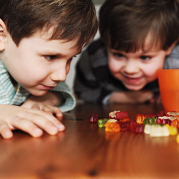Trouble with flexible thinking: Why some kids only see things one way

By Gail Belsky
Expert reviewed by Ellen Braaten, PhD
Quick tips to build flexible thinking
- Quick tip 1Play Fannee Doolee.
 Play Fannee Doolee.
Play Fannee Doolee.In this word game, Fannee Doolee likes words that have double letters. For example, Fannee Doolee likes bees but not bugs. She likes jelly but not jam. Take turns coming up with pairs of words Fannee likes and dislikes.
- Quick tip 2Ask “How many ways…?”Ask “How many ways…?”
Gather different objects like beads, crayons, and buttons. Then ask, “How many ways can we make the number 10?” Take turns picking objects to show different combinations that equal 10 — like two beads, five crayons, and three buttons.
- Quick tip 3Play “Yes, and….”
 Play “Yes, and….”
Play “Yes, and….”One partner sets the scene with a statement like “It’s a cold day here in the mountains.” The next person adds on to it: “Yes, and I can’t seem to find my winter boots.” Go back and forth making “Yes, and…” statements until the story ends.
- Quick tip 4Pretend what objects can be.
 Pretend what objects can be.
Pretend what objects can be.Take a regular object and help kids see how many things they can pretend it is. For example, a funnel could be a party hat, a trumpet, and a unicorn horn. A whiteboard eraser could be a phone, a microphone, and a mustache.
Some kids have trouble switching gears. Changes to a schedule make them anxious or angry. They struggle to cope with change because they can only see one possible schedule or solution.
These kids struggle with a skill called flexible thinking. Their challenges with finding different approaches to problems can have a big impact on learning and everyday living.
When faced with a problem, kids who struggle with flexible thinking might freeze and do nothing. Or they might try the same strategy over and over, even if it’s not working.
This rigid way of thinking can show up during conversations. For example, kids may not understand that some words have two meanings. It can also show up in schoolwork, like when kids use a math strategy that works for one type of word problem but not with another.
Flexible thinking is part of a group of skills called . Trouble with these skills is common in kids with . But other kids who learn and think differently can also struggle with flexible thinking.
Slow processing speed can also play a role in being able to quickly switch gears and think of solutions.
Dive deeper
Signs of struggle with flexible thinking
Kids who struggle with flexible thinking might have trouble at home and at school. The situations are different. But the challenge is the same: not yet being able to see things from different angles, or not yet being able to use different strategies to solve problems.
Here are some behaviors you might see at home and at school:
Not accepting other people’s ideas
Arguing the same point over and over
Getting frustrated when even small things go wrong
Repeating the same mistakes
Not following new schedules
Getting anxious when plans change
Struggling to take on new, more complicated tasks
Having trouble switching from one activity to another
Getting upset when others don’t follow rules
Many of these behaviors can be signs of ADHD. Explore more signs of ADHD at different ages.
Next steps
One way to help kids with flexible thinking is to break down tasks into smaller chunks. Another is to help kids plan out how they’re going to approach tasks or problems. Ask them to think about what else they could try if their first strategy doesn’t work.
You can offer ideas, too. This shows them there are options and can cut down on anxiety.
Families and teachers should connect if they notice kids struggling with flexible thinking. Together you can find ways to help. You can also talk about whether to do a free evaluation at school. The testing can show where kids are struggling, where they’re doing well, and how to support them.
Parents and caregivers: Learn more about free school evaluations.
Educators: Explore classroom accommodations that help kids who struggle with executive function.


